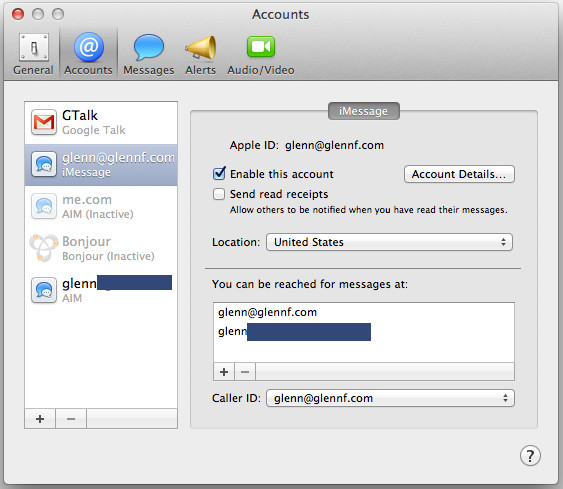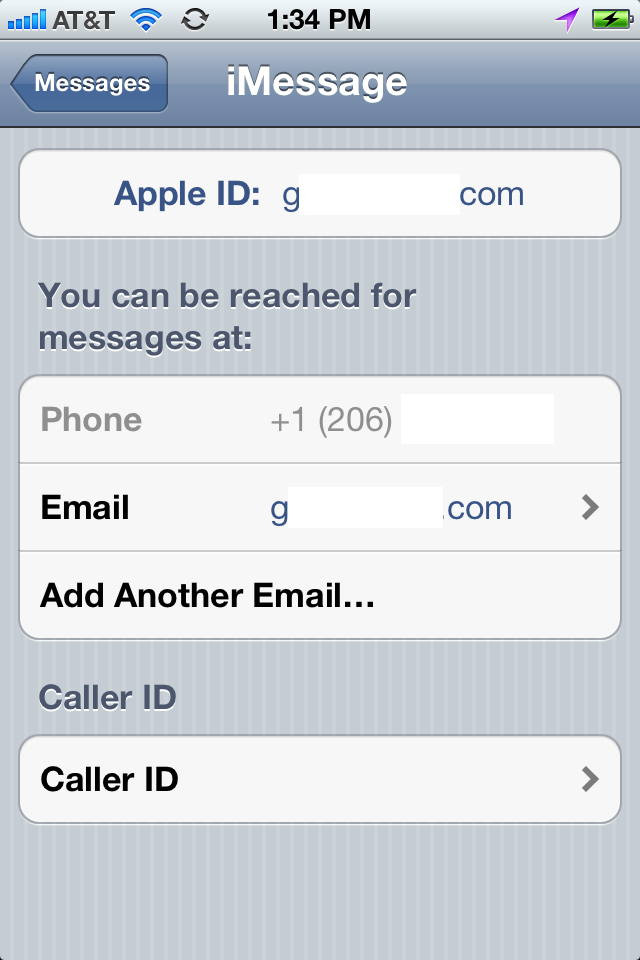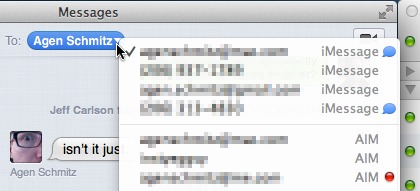Caller ID in Messages Helps to Direct iMessages
The Messages app in OS X 10.8 Mountain Lion confuses the heck out of us because we never know where a given iMessage we send or receive will wind up. Some people are irritated at having an incoming message pop up on an iPhone, iPad, and multiple Macs all at once. There’s no hope for that, as Apple doesn’t yet let you set a single incoming device for iMessage based on where your eyeballs are focused at the moment.
But the contrary problem is also baffling: what if you can’t get iMessages to appear on all your devices registered with the same Apple ID? We figured out the issue, which can let you both turn on that “feature” or disable it. The key is “Caller ID,” a preference that appears when you have multiple addresses registered in Messages in Mountain Lion or in iOS. (For an iPhone, the phone number counts as an address, so even a single email address produces this option.)
In Mountain Lion, you find the Caller ID setting in Messages > Preferences > Accounts: select your iMessage account, and the Caller ID menu appears at the bottom if multiple addresses are registered. In iOS, look in Settings > Messages > Receive At > Caller ID to find it.
Caller ID defines what the iOS and Mountain Lion Messages apps use as the implicit “from” address when sending an iMessage to another party. When the other person replies, her reply is directed to your Caller ID address. That’s straightforward enough. But where it gets tricky is when you have a
different set of email addresses associated with each iOS device and Mac.
For instance, let’s say Jeff has [email protected], [email protected], and [email protected] all associated with Messages in Mountain Lion on his MacBook Pro. On his iPhone, he has just [email protected], and on his iPad, just [email protected]. (This isn’t just hypothetical; in the process of testing, he realized that he’d set up each device with different addresses.)
If Caller ID on Mountain Lion has [email protected] selected, when he sends a text using Messages, the reply will return only to his Mac. If Jeff changes Caller ID to his [email protected] address, then responses come to his Mac and iPhone; if it’s changed to [email protected], then to his Mac and iPad.
Now, Glenn can send Jeff an iMessage to any of those three email addresses, and the note will come in to his Mountain Lion chat window. But when he replies, Messages in Mountain Lion always changes the from address back to his Caller ID address. If Glenn, in turn, replies to that reply and doesn’t change the recipient address, his responses go just to the devices associated with that email address. (In Messages, in the Messages window, you can hover over the person’s name after the “To:” label in a Conversation, and then click the downward-pointing arrow — not the name — to switch the account to which you want to address a message.)
This provides you with a couple of possibilities.
- You can ensure that all devices receive all messages, by either making sure the same email addresses are entered or setting the Caller ID on each device to a common email address. For the moment, this is the most sensible approach for most people.
- You could set up device-specific iMessage accounts and mark each as the Caller ID sender for its particular device. This is a little absurd, but it would work for enabling you to receive an incoming message on all devices, but have subsequent replies directed only to a particular device. For example, Glenn could set up [email protected] on each of his devices, so iMessages to that address would show up everywhere. But, if the Caller ID address for his Mac was [email protected] and his iPhone was [email protected], responses to his iPhone-generated replies would come back solely to the iPhone. Similarly, when he initiates a conversation from a given device, his recipient doesn’t need to know that’s where it comes from;
they just reply.
Of course, this second approach highlights one of the main frustrations with iMessage. If someone stores this device-specific address and creates a new message later — instead of replying to Glenn’s last message or using his general iMessage address — they may send it to a device he’s not using! Also, only iPhones can use a phone number as an iMessage account, so it’s entirely possible that a friend will send a text to Glenn’s phone number and ignore any previous iMessage conversation, thus forcing the conversation to go only to his iPhone.
So, although you may have a small measure of control over which address is sent with your outgoing messages, you still can’t dictate how other people always send messages to you without relying on just one address for all devices.
This all serves to demonstrate the missing pieces in iMessage. Apple seems to not want to provide centralized management of email associated with accounts, leaving that up to the individual device. But Apple does validate email addresses that are used with iMessage centrally, and confirms that each non-Apple ID address is associated with only one Apple ID account at a time. A little bit of help in clarifying what goes where, even if we need a Web site or preference pane to manage the information, would eliminate a lot of confusion and unnecessary fiddling.



What about phone numbers in OS X? People can send iMessages to my phone number, and they will simultaneously appear on both my iPhone and my iPad (running iOS 6), but the Messages app never receives those iMessages because you can't attach a phone number to the Messages app. Furthermore, if you read an iMessage, it appears as "read" on all your iOS devices, but still shows up as "unread" on your Mac. It's all just too much work and confusion right now (because Apple clearly hasn't thought through any of this), so we've completely disabled the iMessage account within the Messages app on our Mac. Welcome to post-Steve Apple.
Send all messages to my Phone number no matter the device! Simple
Another whole kettle of fish!
I have been trying to "Message" someone I work with in China. He has a Iphone 4.0 but have been unable to connect with him on Mountain Lion or on my wifi Ipad 3. On my Iphone 4 it works just fine. He is on a U.S Carrier. Got any ideas how can we hook up? He has "message" on his iphone enabled. Thanks
Sounds like he needs to make sure a particular email address is set in Settings > Messages >Receive At and then you need to direct messages to that address.
One thing worth bearing in mind - rather than setting up lots of email accounts per device, you can use the + notation, ie: [email protected], [email protected] - should stop you having to create lots of different email addresses.
I haven't tested whether Apple allows + addresses (which work with some services, but not all). Some sites won't let you use a + even though that's perfectly legitimate.
Sending an imessage from iPhone to an email address breaks fallback to SMS text because there is no way to know which phone number to send the sms to. Just filed a bugreport requesting that phone numbers can be associated with Messages.app accounts
So, the thing I don't understand completely! if I set my iPhone's caller ID to my Apple ID and someone texts to my phone number, will the person texting to the phone number still be sending an iMessage? If I knew for sure I could set the caller ID and still have the phone number behave the same as it does now on the iPhone, I would do it.
As long as someone is using Messages in iOS (and has iMessage turned on) or Messages in Mountain Lion (and is directed to a phone number that has an iMessage icon next to it in the pop-up menu), it's an iMessage.
You can use Messages to send iMessages to any address that's associated with the Apple ID that's logged in for iMessage plus the phone number of an iPhone.